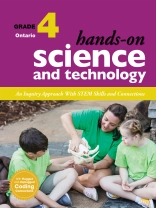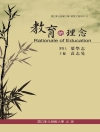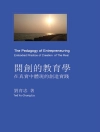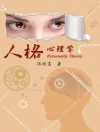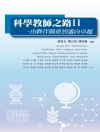Hands-On Science and Technology for Ontario, Grade 4 is an easy-to-use resource for teaching the five strands of the Ontario science and technology (2022) curriculum:
- STEM Skills and Connections
- Life Systems: Habitats and Communities
- Matter and Energy: Light and Sound
- Structures and Mechanisms: Pulleys and Gears
- Earth and Space Systems: Rocks and Minerals
Hands-On Science and Technology for Ontario, Grade 4 encourages students’ natural curiosity about science and the world around them as they participate in hands-on activities and explore their environment. Using the inquiry approach, this comprehensive resource
- fosters students’ understanding of STEM (science, technology, engineering, and mathematics) skills
- makes coding and emerging technologies approachable for both teachers and students
- emphasizes personalized learning using a four-part instructional process: activate, action, consolidate and debrief, enhance
- relates science and technology to sustainability and our changing world, including society, the economy, and the environment
- focuses on practical applications of the engineering design process as students work on solutions to real-life problems
- builds understanding of Indigenous knowledge and perspectives specific to Ontario
- explores contributions to science and technology by people with diverse lived experiences
Using proven Hands-On features, this book provides resources for both teachers and students including background information on the science topics; complete, easy-to-follow lesson plans; materials lists; and digital image banks and reproducibles (find download instructions in the Appendix of the book).
Innovative elements developed specifically for the Ontario curriculum include the following:
- plugged and unplugged coding activities in nearly every lesson
- land-based learning activities
- opportunities for students to use guided research, hands-on inquiry, and the engineering design process
- a fully developed assessment plan to guide assessment for, as, and of learning
- ideas and prompts for STEM Makerspace projects
Inhoudsopgave
Introduction to Hands-On Science and Technology for Ontario, Grade 4
- Introduction to Hands-On Science and Technology 2
- Program Introduction 2
- The Inquiry Approach to Science and Technology 2
- 21st Century Teaching and Learning 3
- The Goals of the Science and Technology Program 3
- Hands-On Science and Technology Strands and Expectations 4
- Hands-On Science and Technology Fundamental Concepts and Big Ideas 4
- Hands-On Science and Technology Program Principles 4
- Infusing Indigenous Perspectives 5
- Cultural Connections 6
- Land-Based Learning 7
- Technology 7
- Sustainability 7
- Program Implementation 7
- Program Resources 7
- Classroom Environment 11
- Planning Units–Timelines 11
- Classroom Management 11
- Classroom Safety 12
- Scientific Inquiry Skills: Guidelines for Teachers 12
- Observing 12
- Questioning 12
- Exploring 12
- Classifying 13
- Measuring 13
- Communicating, Analyzing, and Interpreting 13
- Predicting 15
- Inferring 15
- Inquiry Through Investigation and Experiments 16
- Inquiry Through Research 16
- Online Considerations 17
- Addressing Students’ Literacy Needs 17
- Technological Problem Solving 17
- Makerspace 18
The Hands-On Science and Technology Assessment Plan 20
- Assessment for Learning 21
- Assessment as Learning 21
- Assessment of Learning 22
- Performance Assessment 23
- Portfolios 23
- Evidence of Student Achievement Levels for Evaluation 24
- Important Note to Teachers 24
- References 25
- Assessment Reproducibles 26
- Achievement Chart for Science & Technology 41
Unit 1: Habitats and Communities 43
- Introduction 44
- Unit Overview 48
- Curriculum Correlation 49
- Resources for Students 51
- 1 What Do We Know About Habitats and Communities? 55
- 2 Why Do Plants and Animals Live in Certain Habitats? 63
- 3 Which Organisms Are Found in Our Local Habitats? 68
- 4 How Can We Measure Populations in a Habitat? 74
- 5 How Do Plants and Animals Adapt to Survive in Their Environment? 79
- 6 What Relationships Occur Between Populations Within a Community? 86
- 7 What Are the Characteristics of Herbivores, Carnivores, and Omnivores? 91
- 8 What Are the Relationships Between Predators, Prey, and Scavengers? 96
- 9 What Are the Characteristics of Producers, Consumers, and Decomposers? 100
- 10 What Is a Food Chain? 106
- 11 What Is a Food Web? 111
- 12 How Are Plants and Animals Important to Humans and to the Environment? 115
- 13 How Can We Create Living Habitats? 120
- 14 What Are Some Natural and Human Impacts on Organisms in the Environment? 123
- 15 Inquiry Project: What Can I Do to Protect Habitats and Communities? 128
Unit 2: Pulleys and Gears 133
- Introduction 134
- Unit Overview 138
- Curriculum Correlation 139
- Resources for Students 140
- 1 What Do We Know About Forces and Machines? 143
- 2 How Do Wheels and Axles Work? 148
- 3 How Do Gears Help Make Work Easier? 154
- 4 What Can We Learn About Gears and Direction of Movement? 159
- 5 How Can We Design and Construct Devices With Working Gears? 165
- 6 How Does a Single-Fixed Pulley Make Work Easier? 168
- 7 How Do Movable and Compound Pulleys Make Work Easier? 173
- 8 How Can We Design and Construct a Working Pulley System? 180
- 9 What Are the Advantages and Disadvantages of Using Machines With Pulleys and Gears? 184
- 10 Inquiry Project: How Can We Design and Build a System of Pulleys and Gears for a Specific Purpose? 188
Unit 3: Light and Sound 191
- Introduction 192
- Unit Overview 197
- Curriculum Correlation 198
- Resources for Students 199
- 1 What Do We Know About Light? 203
- 2 How Does Light Travel? 208
- 3 How Does Light Reflect? 213
- 4 How Well Does Light Pass Through Different Materials? 218
- 5 How Can We See Light&rsquo s Many Colours? 222
- 6 How Has Light Technology Changed Over Time? 226
- 7 Inquiry Project: How Can I Design and Construct an Optical Device to Transmit and Reflect Light? 230
- 8 What Do We Want to Learn About Sound? 234
- 9 How Is Sound Created? 239
- 10 What Is Pitch? 244
- 11 How Do Sound Waves Travel? 249
- 12 Which Materials Are Insulators or Conductors of Sound? 253
- 13 How Can We Amplify Sound? 257
- 14 How Do We Hear Sound, and How Can We Protect Our Sense of Hearing? 261
- 15 How Do Musical Instruments Use Sound Energy? 267
- 16 How Can We Design and Construct Musical Instruments Using Various Materials? 272
- 17 Inquiry Project: What Can We Learn About Sound Technology? 278
Unit 4: Rocks and Minerals 281
- Introduction 282
- Unit Overview 285
- Curriculum Correlation 286
- Resources for Students 287
- 1 What Do We Know About Rocks and Minerals? 289
- 2 How Can We Compare and Classify Rocks and Minerals? 295
- 3 How Can Minerals Be Classified? 299
- 4 How Are Different Types of Rock Formed? 304
- 5 What Are Some Uses for Rocks and Minerals? 313
- 6 How Are Fossils Formed? 319
- 7 Inquiry Project: How Are Rocks and Minerals Mined From the Earth? 324
- 8 How Does Mining Impact Habitats and Communities? 327
- References 332
Appendix: Image Banks 333
About the Contributors 342
Over de auteur
Jennifer H. Manitowabi (she/her/hers) is an Ojibway educator and Ph D student at Lakehead University. Throughout her career in education in both Canada and the US, she has worked as a bus driver, classroom teacher, principal, and education director. Jennifer encourages all teachers to incorporate Indigenous worldviews into their lessons and find opportunities to build relationships with the First Nations of Turtle Island. Jennifer is a member of Lac Seul First Nation, where she currently resides, and can often be found creating artwork that celebrates her culture.
